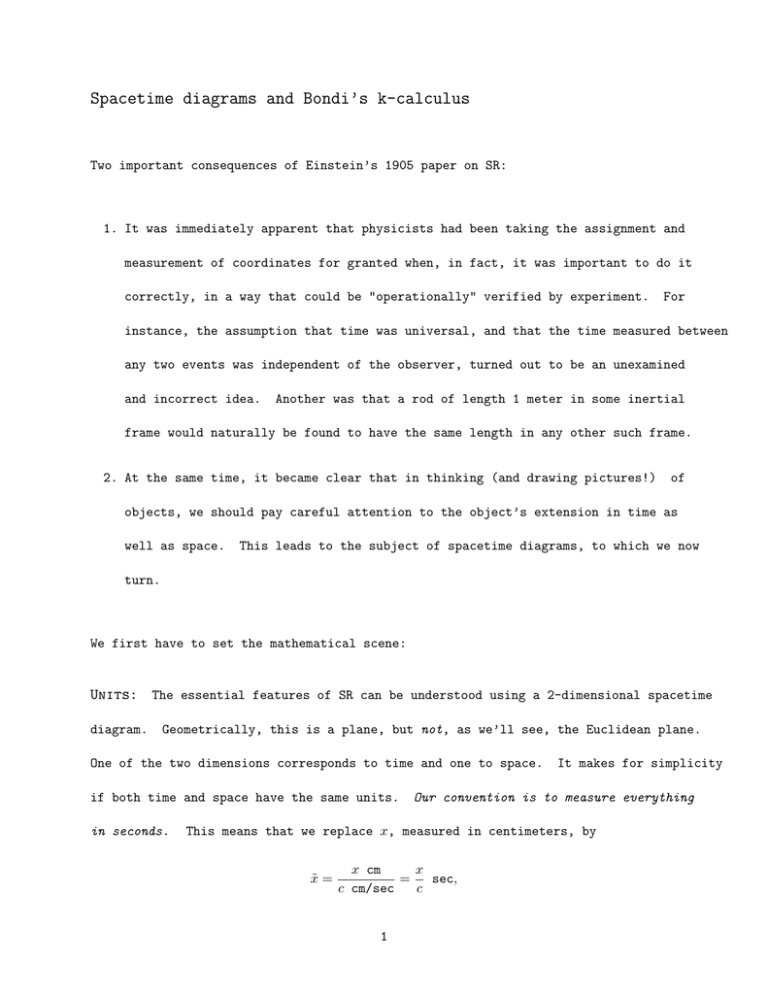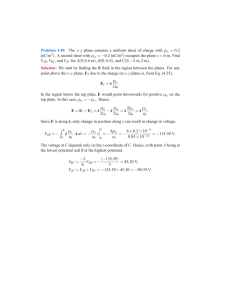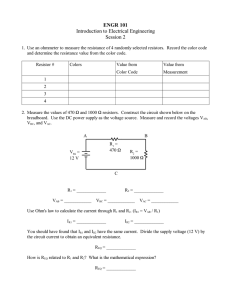Spacetime diagrams and Bondi`s k
advertisement

Spacetime diagrams and Bondi’s k-calculus Two important consequences of Einstein’s 1905 paper on SR: 1. It was immediately apparent that physicists had been taking the assignment and measurement of coordinates for granted when, in fact, it was important to do it correctly, in a way that could be "operationally" verified by experiment. For instance, the assumption that time was universal, and that the time measured between any two events was independent of the observer, turned out to be an unexamined and incorrect idea. Another was that a rod of length 1 meter in some inertial frame would naturally be found to have the same length in any other such frame. 2. At the same time, it became clear that in thinking (and drawing pictures!) of objects, we should pay careful attention to the object’s extension in time as well as space. This leads to the subject of spacetime diagrams, to which we now turn. We first have to set the mathematical scene: Units: The essential features of SR can be understood using a 2-dimensional spacetime diagram. Geometrically, this is a plane, but not, as we’ll see, the Euclidean plane. One of the two dimensions corresponds to time and one to space. if both time and space have the same units. in seconds. It makes for simplicity Our convention is to measure everything This means that we replace x, measured in centimeters, by x̃ = x x cm = sec, c cm/sec c 1 which means: light. x̃ is the time it takes to travel a distance x moving at the speed of Having made this definition, we now remove the accent and just write x. So for example, an object moving at the speed of light will have an equation x = ±t, and will have velocity v = ±1. Notice that in these units, velocity is dimensionless. The conventional units can always be recovered by replacing x and v with x/c and v/c. We make the following assumptions: (1) there exists an inertial observer (one for whom Newton’s first law holds), (2) any other observer moving with constant velocity relative to this one is likewise an inertial observer. will be used synonymously with inertial observer. In what follows, the word observer We also assume that all our observers are equipped with identical standard clocks and with signalling devices which can emit, detect, and reflect light rays. More about this shortly. Points in a spacetime diagram are called events. by two coordinates (ta , xa ). An observer A will label an event The observer has a world line which we label A, and which, in his coordinates, is just the time axis. 2 Points on A’s world line have the coordinates (ta , 0). The light rays, the world lines of photons or quanta of radiation, are drawn with slopes of ±1. Time increases as we move from the bottom to the top of the diagram. Figure 1 shows the world lines of three observers, together with a number of light rays. The k-factor Suppose A and B are two observers in relative motion, and that A emits two photons T seconds apart. If B is motion relative to A, then B will receive the two photons T 0 seconds apart, where T 0 < T if their motion is toward one another and T 0 > T if they’re moving apart. In either case, there’s a number k such that T 0 = kT . If B reflects these two photons back to A, then A will receive them k 2 T seconds apart. The k-factor between A and B is the same as that between B and A; k is also known as the relativistic Doppler shift. See figure 2. 3 Exercises: (a) If 2 1-dimensional observers are in relative motion, then their paths cross. Prior to that event, they are approaching each other, and afterwards, receding from each other. The picture above illustrates the case when they’re receding. By extending the spacetime diagram into the past, show that the k-factor as they approach each other is 1/k. (b) If if there are 3 observers A, B, and C, with k-factors kab , kac , and kbc , then kac = kab kbc . Coordinates We are ready to introduce coordinates in a well-defined way. Fix an observer A and an event E. A measures the distance to E by using radar ranging : he sends a photon to E at time t1 on his clock; the photon is reflected at E and received back by A at time t2 . The round-trip distance travelled by the photon, moving at the speed of light, is just c(t2 −t1 ). This is twice the distance to E. Since c = 1 in our system of units, 4 A infers that E is located at a distance of xa (E) = (1/2)(t2 − t1 ). The event E must also be assigned a time, and sensible choice is the midpoint of the interval [t1 , t2 ]: ta (E) = (1/2)(t2 + t1 ). Note that, given the coordinates (ta , xa ), we have immediately t1 = ta − xa . t2 = ta + xa , (We’ll need this in the derivation of the Lorentz transformation later.) Velocity and the k-factor Not surprisingly, if A and B are in relative motion, their velocity and their k-factor are related. 5 If "we" are observer A and wish to find the velocity of observer B, we need to take two events on B’s worldline, assign coordinates to them, and then compute ∆x/∆t. It doesn’t matter which two events we take - we’re really just computing the slope of a line. So we make an easy choice: since the two are in relative motion, their worldlines cross at a point we label O in the figure above, and which we take as the first event. If we set A’s clock to t = 0 at O, then we know the coordinates of O; they are (0, 0). Reading things off from figure 4, we see that the event E has the coordinates xa (E) = (1/2)(k 2 T − T ), ta (E) = (1/2)(k 2 T + T ). Given the coordinates of O, this means that v = xa (E)/ta (E) = (k 2 T − T )/(k 2 T + T ) = (k 2 − 1)/(k 2 + 1) Exercises: • Show that k2 = 1+v . 1−v • What was the velocity of B relative to A at a time before the event O? Isn’t that cute? We can get all the signs right if we’re tricky like this, but remember that xa has really been defined as a distance, and so sometimes the correct signs have to be put in by hand. • Use a spacetime diagram, similar triangles, etc. to draw the lines ta = constant for some observer A. On the same diagram, draw some of the lines tb = constant for an observer B in relative motion to A. Two events E and F are simultaneous to observer A if they take place at the same time ta . Will they be simultaneous for observer B? This is called the relativity of simultaneity. 6 It is REAL! • By drawing some more pictures convince yourself that if the events E and F are simultaneous for A there exist observers B and C such that E precedes F according to B and F precedes E according to C. The composition of velocities We are about to encounter our first strange result (or second, if you think the relativity of simultaneity is strange). simply add: Remember that in Newtonian mechanics, relative velocities if vab is the velocity of B relative to A, and vbc the velocity of C relative to B, then vac = vab + vbc . If I’m walking at a speed of 5 mph toward the front of a train moving at 70 mph, then my velocity as measured by someone standing by the tracks is 75 mph. However, we already know that if I’m on a rocket ship moving relative to observer A at v = c/2 and shine my flashlight in the direction of motion, then the speed of the light rays as measured by A is not c+c/2; it’s just c. So the Newtonian addition of velocities won’t hold in SR. What does happen can be computed from the k-factors: We start with the fact (exercise above) that for 3 observers, kac = kab kbc . 7 Using the expression for v in terms of k, this means that vac = 2 k2 − 1 kab bc 2 k2 + 1 kab bc after some algebra . . . = vac = (1 + vab )(1 + vbc ) − (1 − vab )(1 − vbc ) or (1 + vab )(1 + vbc ) + (1 − vab )(1 − vbc ) vab + vbc 1 + vab vbc Examples: • Suppose vab = 0.9c (or 0.9 in our units), and vbc = 0.9 too. vac = Then 0.9 + 0.9 1.8 = = 0.994 1 + 0.81 1.81 Exercise: Show that if vab < 1 and vbc < 1, then vac < 1. If you’re moving at less than c, no matter how much acceleration you can muster, you’ll always be moving at less thant c. • On the other hand, suppose vab = vbc = 3 km/sec, (a fairly hefty speed which would take you more than 1/4 of the way around the earth at the equator in an hour). This is "just" 10−5 c, however, and we compute vac = 10−5 + 10−5 , 1 + 10−10 which is 2×10−5 to many decimal places. This is why NASA doesn’t use special relativity when it computes trajectories to the moon. 8


